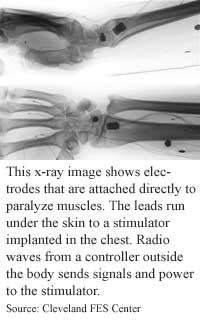
Electronics link mind and body
By Eric Smalley, Technology Research NewsExperiments using brain waves to give people limited control over paralyzed limbs have shown it is feasible to use electronics to bypass damaged portions of the human nervous system.
Researchers at the Cleveland FES Center at Case Western Reserve University have developed a system that uses a series of implanted electrodes to stimulate paralyzed muscles. They have demonstrated the system in a patient who can raise and lower or open and close his hand using brain waves.
"We can stimulate the paralyzed muscles and cause them to contract, and they contract basically the same as if they were being activated voluntarily," said Kevin L. Kilgore, clinical research director of the FES Center. "We stimulate them in a coordinated pattern so that we get the grasp-type functions that we want."
To control the electrical stimulation, the researchers modified a system that allows paralyzed patients to use brain waves to move a cursor. "We thought if [patients] could control a cursor on a computer screen why couldn't they control their hand opening and closing," said Kilgore.
The cursor control system, developed at the Wadsworth Center at the New York State Department of Health, records brain waves through electrodes attached to the scalp.
The researchers were able to use brain waves as the control signals for the implanted electrodes. The brain wave control, however, was slower and more limited than a previous version of the system that uses movement of the patient's opposite shoulder as the control signal.
"It turns out that although you can control those brain waves your control over them is fairly slow, so it takes a second or two to generate the control signal," Kilgore said. In contrast, the shoulder-controlled system has signal delays of about 1/10 of a second, he said.
Because there are only four types of brain waves -- beta, alpha, theta and delta -- the number of movements patients can control is necessarily limited. The cursor movement control, for example, consists simply of four directions.
In theory, signals recorded from directly inside the brain could provide a better source of control signals, said Kilgore.
"There's a lot more you can harness. Ultimately what you'd like to be able to do is find regions in the brain that are already generating signals for, let's say, hand opening and closing, or arm movement, and record directly from those," he said.
There are research efforts under way to capture signals from within the brain. An Emory University School of Medicine team, for example, has implanted an electrode in the brain of a human patient and has used the electrode to give the patient control of a cursor on a computer screen.
Still, there is a long way go from implanting an electrode to recording signals capable of giving a patient control over a limb.
"The tricky part is finding [a signal] that's consistent enough to use as a trigger and unique enough that it's only going to be occurring when the patient wants to do whatever the activity is," said Lucinda Baker, associate professor in the biokinesiology and physical therapy department at the University of Southern California.
Though it's a very difficult challenge, functional MRI and other tools that give researchers a view of activity in the brain could guide the researchers' efforts, she said.
"I'd be surprised if, say, in 10 years we don't have a patient who has something implanted in their brain that at least records some of the signals and that we aren't at least starting to use that to control some of functions that the stimulation provides," said Kilgore.
In any event, the shoulder controlled system is an important advance, said Baker. "What they've got now is nicely packaged and it's looking like a really useful tool for a fair number of patients," she said.
The Cleveland FES Center's research is funded by the National Institutes of Health and the Ron Shapiro Foundation.
Timeline: > 10 years
Funding: Government; Private
TRN Categories: Applied Computing
Story Type: News
Related Elements: Photo
Advertisements:
November 8, 2000
Page One
Electronics link mind and body
Chip promises faster light-to-circuit link
Coffee effect could benefit circuit connections
Tiny silicon crystals loom large
Switch offers cheap local-long distance link

News:
Research News Roundup
Research Watch blog
Features:
View from the High Ground Q&A
How It Works
RSS Feeds:
News
Ad links:
Buy an ad link
| Advertisements:
|
 |
Ad links: Clear History
Buy an ad link
|
TRN
Newswire and Headline Feeds for Web sites
|
© Copyright Technology Research News, LLC 2000-2006. All rights reserved.